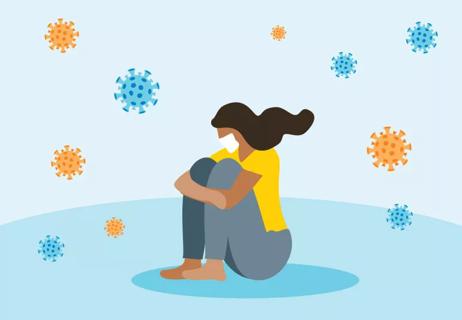Get vaccinated, consider wearing a mask and stock your medicine cabinet

The flu can be a serious illness. And while we all know how it feels to be laid up with the flu (fever, body aches, stuffy or runny nose), it doesn’t mean it’s any easier to deal with the virus when it happens to you.
Advertisement
Cleveland Clinic is a non-profit academic medical center. Advertising on our site helps support our mission. We do not endorse non-Cleveland Clinic products or services. Policy
So, what steps can you take to protect yourself and your loved ones?
Infectious disease specialist Kristin Englund, MD, shares how to prepare for flu season, as well as what you can do if you do get the flu this year.
It starts with getting your flu shot, but there’s a few other things you can do as well to help reduce the likelihood you’ll get the flu.
Studies show the flu vaccine reduces your risk of flu illness overall and makes it less likely that you’ll get severely sick if you do become infected.
“The flu vaccine not only protects you, but it also protects all the loved ones around you,” says Dr. Englund.
The U.S. Centers for Disease Control and Prevention (CDC) recommends that everyone over the age of 6 months gets vaccinated.
“We recommend that people get a flu vaccine in September and October so we’re prepared for the beginning parts of the flu season,” Dr. Englund concurs. “We have seen in recent years that flu season can show up sooner and last a lot longer. So, it’s really important to get the flu vaccine as soon as it’s available for you.”
While it’s not required to wear a mask — even when you’re sick — it all comes down to personal preference (you may choose to wear one during your weekly grocery shopping) and doing your part of limit the spread of viruses like the flu and COVID-19.
Advertisement
Additionally, masking can protect you from getting sick in other ways.
“I would encourage you to wear masks during the respiratory illness season,” says Dr. Englund. “There’s a lot of different viruses that can cause harm, not just COVID-19 or the flu.”
The flu virus spreads through droplets from the nose or mouth.
Many of the things you’ve done in the past to prevent the spread of COVID-19 — like getting vaccinated, wearing a mask in public, staying six feet away from others and washing your hands frequently — could also reduce your chances of being exposed to the flu virus.
“I’m very comfortable continuing to wear my mask and using hand hygiene and social distancing when I go out in public, even though I’ve been COVID-19 vaccinated and will be flu vaccinated,” Dr. Englund shares.
The flu and COVID-19 have many overlapping symptoms, such as fever, cough, shortness of breath and muscle aches.
If you develop these symptoms, call a healthcare provider. They can let you know what to do next and if you should be tested for the flu or COVID-19, or get a prescription for a COVID-specific antiviral treatment or an antiviral treatment for the flu.
You can also prepare for the flu at home. Dr. Englund suggests keeping a few items handy in case the flu hits: A fever reducer like acetaminophen (Tylenol®), ibuprofen for muscle aches, cough syrup and a thermometer.
“There are a lot of great over-the-counter medications that you can use just for symptomatic relief,” she continues. “Get a flu and cold medication to also help cut down on the nasal stuffiness and the cough that you might have.”
If you have an underlying condition that puts you at greater risk for severe illness, it may also be helpful to have a pulse oximeter at home, which measures the levels of oxygen in your blood.
If you get the flu, you’ll want to stay home until you feel better to avoid passing it on to others.
“A person is most likely to spread influenza to others the day before they develop symptoms and for the next five to seven days,” explains Dr. Englund. “Stay home, drink plenty of water and rest. If you must be in contact with others, wear a mask. Contact your doctor to see if you are a candidate for the antiviral medications that can shorten your time of feeling poorly.”
Winter is also prime time for other contagious viral illnesses like respiratory syncytial virus or RSV (which commonly infects children) and norovirus (a stomach bug).
Many of the recommendations for curbing the spread of the flu can also help keep these viruses at bay. Washing your hands frequently, disinfecting high-touch surfaces often, practicing good cough etiquette and staying home when you’re sick are good practices during the winter no matter what.
Advertisement
“I think we’re going to have to get very comfortable with practicing all of these preventative measures,” Dr. Englund says.
“Masks, for example, may become a routine part of our lives during these severe respiratory illness seasons. And that’s OK, if we’re able to protect people and lower the number of deaths. With these preventative measures, we’re not only protecting ourselves, but we’re protecting those around us.”
Advertisement
Learn more about our editorial process.
Advertisement

While it typically starts in October, vaccine effectiveness can affect its duration and severity

Influenza puts stress on your body and can lead to serious conditions like pneumonia or stroke

There are three antigenic types of influenza, but A and B are responsible for our flu season

Resting, staying hydrated and taking over-the-counter medicine can help you recover quickly

You can spread the flu to others a day before you feel sick and for several days after

The antiviral medication can help curb symptoms and shorten recovery time

These nutritious foods will help your body to better fight the flu

Colds and the flu are still lurking this winter

Type 2 diabetes isn’t inevitable with these dietary changes

Applying a hot or cold compress can help with pain